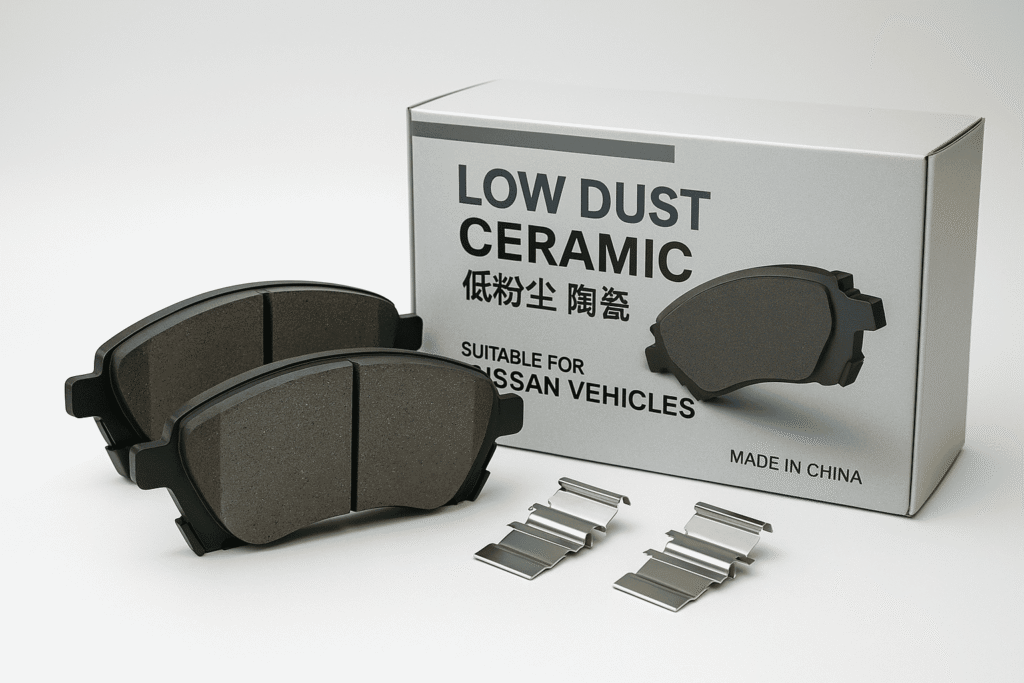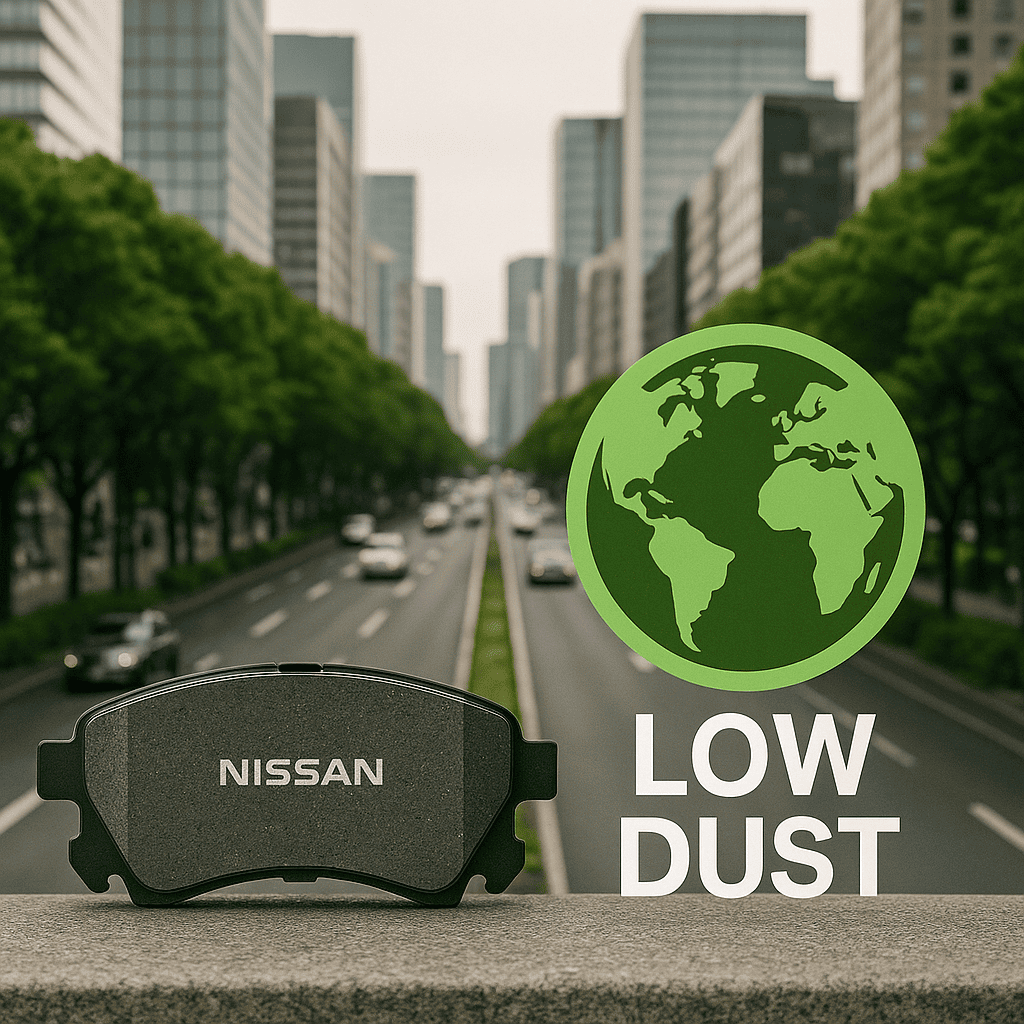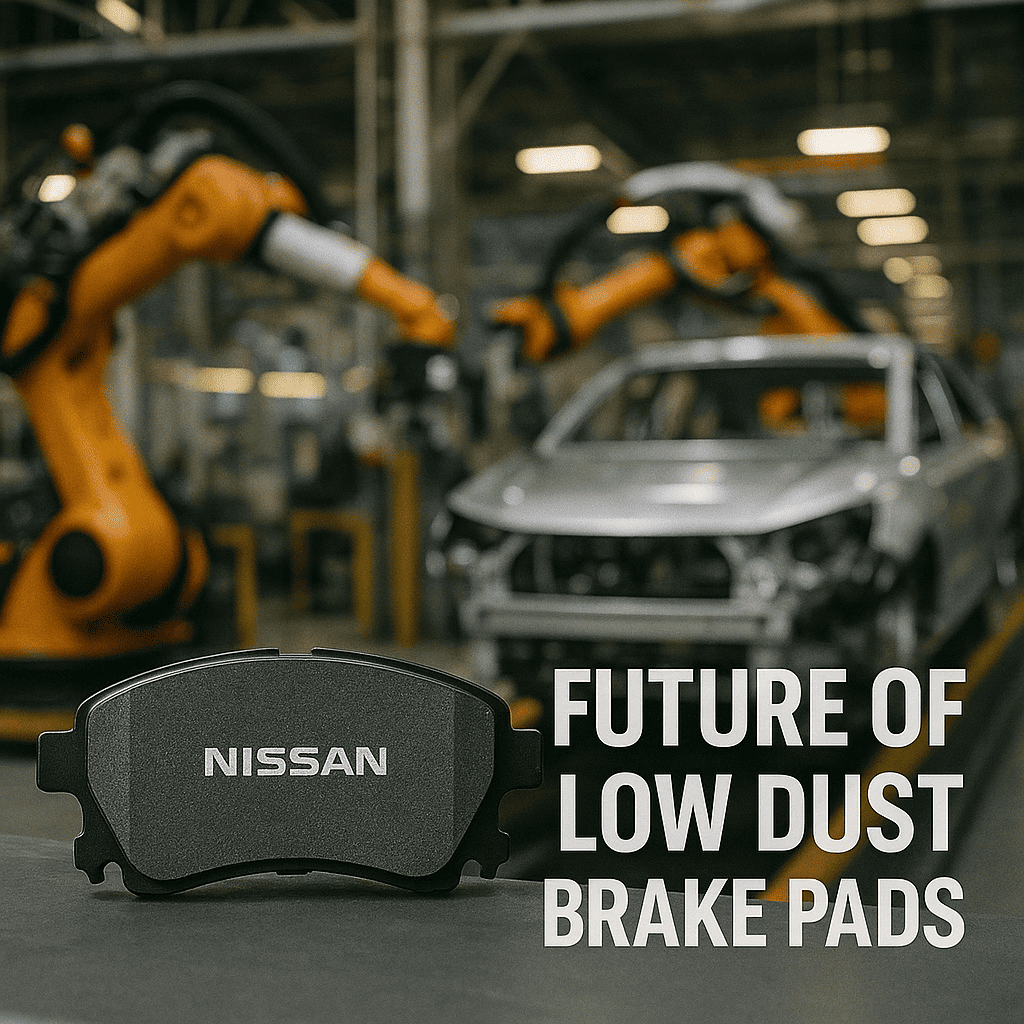Ultimate Guide to Low Dust Nissan Brake Pads China – 10 Reasons They Outperform Standard Pads
Low Dust Nissan Brake Pads China: Comprehensive Guide for Performance & Reliability
Introduction to Low Dust Nissan Brake Pads China
Low dust Nissan brake pads China are designed to deliver superior braking performance while minimizing dust emissions that can stain wheels and affect air quality. As a trusted supplier in the automotive aftermarket, G-sparts ensures its products meet the highest international standards of safety and durability. These brake pads are engineered for Nissan vehicles ranging from compact sedans to heavy-duty commercial models. By reducing particulate emissions, they contribute to a cleaner driving experience and align with global environmental goals. In this guide, we’ll explore the composition, standards, applications, and benefits of low dust Nissan brake pads China, giving buyers and engineers the insights they need to make informed decisions.
Composition of Low Dust Nissan Brake Pads
The performance of low dust Nissan brake pads China depends largely on their material formulation. Modern pads often combine low-metallic and ceramic-based compounds to balance durability, friction stability, and reduced dust generation. Ceramic fibers provide heat resistance and stability, while small amounts of copper or steel improve strength and wear resistance. Organic binders hold the mixture together, ensuring even wear during braking cycles. The result is a friction material that produces significantly less dust than traditional semi-metallic pads, keeping wheels cleaner and reducing health hazards associated with brake particulate emissions. This optimized formulation is what makes low dust Nissan brake pads China a smart investment for modern drivers.

Friction Materials and Additives
To enhance performance, manufacturers incorporate specific additives into low dust Nissan brake pads China. Graphite reduces noise and improves lubrication at high temperatures. Kevlar fibers may be added for extra strength and durability. Small amounts of copper improve heat dissipation but are carefully regulated to meet environmental restrictions in regions like North America and Europe. Additionally, abrasives such as alumina or silica ensure consistent braking efficiency without excessive wear on the rotors. Each component is carefully selected to achieve the right balance between braking power, longevity, and low dust emission. This engineering precision ensures Nissan vehicles equipped with these pads deliver smooth, reliable braking under varied conditions.
Manufacturing Standards and Compliance
The production of low dust Nissan brake pads China follows strict international standards to ensure quality, safety, and consistency. Manufacturers adhere to ASTM guidelines, which define the testing methods for friction materials, hardness, and wear resistance. Compliance with these standards ensures that every batch meets minimum performance criteria under diverse driving conditions. In addition to ASTM, brake pad suppliers also align with ISO quality management systems, guaranteeing that production processes remain consistent across facilities. By integrating advanced testing protocols into manufacturing, suppliers in China deliver brake pads that rival or exceed international benchmarks. This commitment to standards ensures customers receive safe, durable, and reliable braking solutions for their Nissan vehicles.
ASTM Standards for Brake Materials
ASTM International provides several standards that directly apply to friction materials used in brake pads. For example, ASTM D3702 evaluates wear resistance, while ASTM D1894 focuses on coefficient of friction measurements. These benchmarks help manufacturers design low dust Nissan brake pads China that maintain stable performance across temperature ranges, from cold starts to prolonged high-speed braking. By following ASTM standards, producers minimize risks of uneven wear, brake fade, or premature failure. Such consistency is critical for Nissan drivers who expect reliable braking performance under urban traffic conditions or highway speeds. Compliance with ASTM guidelines not only assures product quality but also enhances trust in Chinese suppliers on the global stage.
ISO and ECE R90 Certification
Beyond ASTM, two critical certifications—ISO 9001 and ECE R90—play a central role in brake pad manufacturing. ISO 9001 establishes a framework for consistent quality management across all stages of production, from raw material sourcing to final inspection. Meanwhile, ECE R90, a European regulation, requires aftermarket brake pads to match the performance of original equipment parts within strict tolerance limits. Manufacturers of low dust Nissan brake pads China who achieve these certifications demonstrate their ability to meet or exceed OEM performance. For global distributors and end-users, these certifications provide confidence that the brake pads are safe, reliable, and suitable for long-term use in diverse driving environments.
Material Blending and Pressing
The manufacturing process begins with precise material blending, where ceramic fibers, low-metallic components, and organic binders are mixed to create the friction compound. This mixture is then pressed into molds under high pressure, forming the basic shape of the brake pad. Consistency at this stage is critical, as it directly influences braking performance, noise reduction, and dust generation. Advanced blending machines ensure uniform distribution of additives, while hydraulic presses compact the mixture to achieve the desired density. This step lays the foundation for high-quality low dust Nissan brake pads China, ensuring they deliver smooth braking and minimal wheel contamination across their lifespan.
Heat Treatment and Curing
After pressing, the brake pads undergo heat treatment and curing, where they are exposed to controlled high temperatures for extended periods. This process strengthens the molecular bonds within the friction material, improving wear resistance and thermal stability. Heat treatment also reduces the risk of pad glazing, a condition that compromises braking efficiency. By carefully controlling temperature cycles, manufacturers achieve consistent hardness and durability across all pads. For low dust Nissan brake pads China, proper curing is especially important, as it ensures the pads generate minimal particulate emissions during use. This step guarantees the final product is both environmentally friendly and performance-driven.
Finishing, Slotting, and Chamfering
The final stage of manufacturing involves finishing operations, including slotting, chamfering, and surface treatment. Slots in the brake pad surface help dissipate heat, reduce noise, and prevent uneven wear. Chamfers on the edges ensure smoother contact with the brake rotor, minimizing vibration and squeal. In addition, surface treatments such as scorching or coating prepare the pads for immediate use, reducing the bedding-in period for drivers. These finishing processes not only enhance comfort and safety but also extend the pad’s service life. With precise finishing, low dust Nissan brake pads China deliver consistent, quiet, and clean braking performance for Nissan vehicles of all classes.
Applications in Nissan Passenger Cars
Low dust Nissan brake pads China are widely used across Nissan passenger cars, including popular models like the Altima, Sentra, and Versa. These vehicles are often driven in city traffic where frequent braking can lead to significant dust buildup on wheels. By using advanced ceramic and low-metallic compounds, these pads reduce visible dust while maintaining consistent stopping power. For daily drivers, this means cleaner wheels, less time spent on maintenance, and reliable braking performance in stop-and-go conditions. G-sparts ensures that its passenger car pads meet or exceed OEM specifications, delivering a safe and comfortable driving experience. This makes low dust technology an attractive option for Nissan car owners seeking both cleanliness and reliability.
Applications in Nissan SUVs and Crossovers
SUVs and crossovers like the Nissan Rogue, Murano, and X-Trail require brake pads that can handle heavier vehicle weights and more demanding conditions. Low dust Nissan brake pads China are engineered to meet these challenges with enhanced durability and improved heat dissipation. These pads minimize brake fade during extended downhill driving or highway cruising while producing less dust compared to traditional semi-metallic options. For families and individuals who value safety and comfort, the use of low dust pads ensures a smoother driving experience and reduced maintenance costs. By combining strength with low emission technology, these brake pads perfectly match the needs of Nissan SUV and crossover drivers worldwide.
Applications in Nissan Commercial Vehicles
Nissan’s commercial line, including the Navara pickup and NV vans, demands heavy-duty brake pads that can withstand high loads and constant use. Low dust Nissan brake pads China are specifically designed to provide long-lasting performance in these demanding applications. Their reinforced ceramic and low-metallic formulations deliver consistent braking even under high-stress conditions. For logistics companies, fleet managers, and commercial drivers, reduced dust not only means cleaner wheels but also improved rotor longevity, lowering overall maintenance costs. With strict compliance to international standards, G-sparts ensures its commercial-grade pads meet professional expectations, providing businesses with dependable braking solutions that enhance both safety and operational efficiency.
Reduced Dust Emission and Cleaner Wheels
One of the most noticeable benefits of low dust Nissan brake pads China is the reduction of brake dust accumulation on wheels. Traditional semi-metallic pads release dark, powdery residues that stain rims and require frequent cleaning. By contrast, low dust pads generate lighter, finer particles that are less visible and less adhesive. This translates into cleaner wheels and an improved overall appearance of the vehicle. Beyond aesthetics, reducing brake dust also lowers exposure to harmful particulate matter, contributing to healthier air quality in urban environments. For both individual drivers and fleets, the benefit of reduced dust is clear—less maintenance, better appearance, and improved environmental impact.

Extended Lifespan and Durability
Durability is another critical advantage of low dust Nissan brake pads China. Their advanced material composition ensures even wear, reducing the need for frequent replacements. The ceramic and reinforced additives used in these pads improve heat resistance, preventing premature glazing and cracking. For drivers covering long distances or handling heavy loads, this translates into longer service life and fewer maintenance interruptions. Fleet operators benefit especially, as longer-lasting pads mean reduced downtime and lower total operating costs. By combining durability with consistent braking performance, low dust technology offers a cost-effective solution that satisfies both individual car owners and commercial enterprises.
Enhanced Braking Performance and Comfort
In addition to durability and cleanliness, low dust Nissan brake pads China deliver enhanced braking performance and comfort. Their optimized friction materials ensure smooth and quiet braking, minimizing squealing and vibration. This is particularly valuable in urban environments where stop-and-go traffic can amplify brake noise. The pads also maintain a stable coefficient of friction across temperature ranges, ensuring consistent stopping distances in both hot and cold conditions. For Nissan owners, this translates into improved safety and a more comfortable driving experience. By reducing noise, vibration, and harshness (NVH), these pads enhance overall vehicle performance while meeting the growing demand for cleaner, safer braking solutions.
Semi-Metallic vs. Low Dust Brake Pads
Semi-metallic brake pads have long been popular due to their affordability and high friction levels. However, they generate significant brake dust and can be noisy under heavy braking. In contrast, low dust Nissan brake pads China provide cleaner operation, reduced wheel staining, and quieter performance. While semi-metallic pads may excel in extreme-duty applications, they often wear rotors more aggressively, increasing maintenance costs. For daily drivers and fleets seeking balance between performance, cleanliness, and comfort, low dust brake pads offer superior long-term value. This shift highlights why more customers worldwide are turning to advanced materials for a better driving experience without sacrificing safety or reliability.
Ceramic vs. Organic Pads
Organic brake pads, made largely from resins and natural fibers, are generally inexpensive but lack durability under high-stress conditions. Ceramic-based low dust Nissan brake pads China, on the other hand, provide longer lifespan, better heat resistance, and significantly less dust production. While ceramics may carry a higher upfront cost, their reduced maintenance needs and cleaner operation often offset the price difference over time. Moreover, ceramic pads generate less noise and vibration, enhancing driver comfort. For Nissan owners who value both performance and convenience, ceramic low dust brake pads represent a clear upgrade over organic alternatives. They combine efficiency, reliability, and eco-friendliness in a single product.
Global Market Insights
The global brake pad market continues to expand, driven by increased vehicle ownership, stricter emission regulations, and growing demand for low-maintenance solutions. According to the World Steel Association and industry analysts, Asia-Pacific, led by China, dominates brake pad production due to its advanced manufacturing capacity and cost efficiency. Low dust Nissan brake pads China have gained international recognition for combining affordability with high quality, meeting the needs of markets in Europe, North America, and beyond. The growing adoption of low dust technologies reflects a broader shift toward environmentally friendly automotive solutions, aligning with global efforts to reduce air pollution and improve sustainability in transportation.
Quality Assurance and Testing
Ensuring the reliability of brake pads requires rigorous testing and inspection. Manufacturers of low dust Nissan brake pads China employ dynamometer testing to simulate real-world braking conditions, measuring wear rates, friction stability, and thermal performance. Additionally, on-vehicle testing validates comfort factors such as noise, vibration, and harshness (NVH). Compliance with ASTM, ISO, and ECE R90 standards guarantees that the pads meet or exceed OEM benchmarks. Advanced quality control processes—such as hardness testing, chemical analysis, and dimensional checks—further ensure consistency. These strict measures give customers confidence that every pad will perform safely and reliably, regardless of driving conditions or vehicle application.
Environmental Benefits of Low Dust Technology
Beyond vehicle performance, low dust Nissan brake pads China contribute to improved environmental health. Traditional brake pads release fine particulate matter (PM2.5 and PM10), which can accumulate in urban air and pose respiratory risks. By generating significantly less particulate pollution, low dust technology helps cities reduce air contamination linked to vehicle emissions. For eco-conscious drivers and regulatory bodies alike, these pads represent an important step toward sustainable mobility. Choosing brake pads that produce less dust not only preserves wheel aesthetics but also reduces the environmental footprint of everyday driving. G-sparts integrates this technology to support both cleaner vehicles and healthier communities.
Future Outlook for Brake Pad Innovation
The future of braking technology is moving toward even cleaner, quieter, and more efficient solutions. With growing emphasis on electric vehicles (EVs) and hybrid cars, brake systems are evolving to meet new performance requirements. Low dust Nissan brake pads China are expected to play a central role in this transition, as EVs particularly benefit from pads that minimize dust and noise. Research into advanced ceramics, copper-free formulations, and self-lubricating materials continues to push the industry forward. As G-sparts invests in R&D, its brake pad solutions are positioned to meet the needs of next-generation vehicles, ensuring customers stay ahead in a rapidly changing automotive market.

Why Choose G-sparts as Your Supplier
Selecting the right supplier is critical for ensuring both product quality and long-term support. G-sparts has established itself as a trusted source for low dust Nissan brake pads China by combining advanced manufacturing technology, strict quality assurance, and global distribution capabilities. The company offers a wide range of pads designed for various Nissan models, with customization options to meet specific regional standards. By maintaining a strong commitment to innovation and customer satisfaction, G-sparts delivers not only products but also reliable partnerships. Businesses and individual buyers alike can depend on G-sparts for competitive pricing, dependable quality, and timely delivery worldwide.
Conclusion: Cleaner, Safer Braking with G-sparts
Low dust Nissan brake pads China represent the future of clean, efficient, and safe braking technology. With reduced dust emissions, enhanced durability, and superior comfort, they meet the demands of modern Nissan drivers across passenger, SUV, and commercial vehicles. Supported by ASTM, ISO, and ECE R90 certifications, these pads deliver performance equal to or better than OEM standards. As a global supplier, G-sparts provides customers with reliable access to high-quality brake solutions backed by professional expertise and advanced manufacturing. Investing in low dust Nissan brake pads China means choosing cleaner operation, improved vehicle appearance, and long-term cost savings—an undeniable advantage for drivers and businesses worldwide.
Authoritative External References
- ASTM International — Materials & testing frameworks
- World Steel Association — Industry & sustainability
- Stainless steel – Wikipedia — Metallurgy overview
- NiBK — Disc Rotor Product Family


